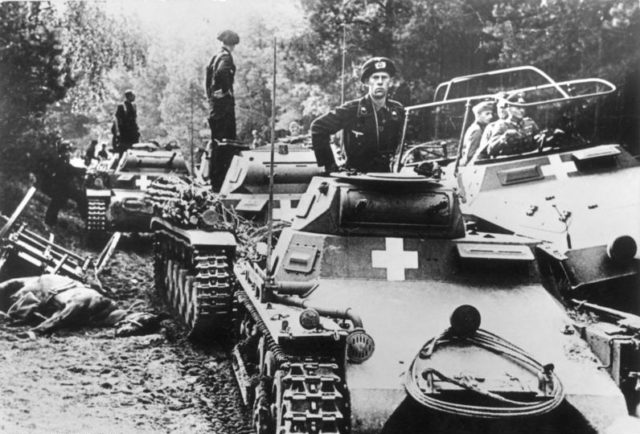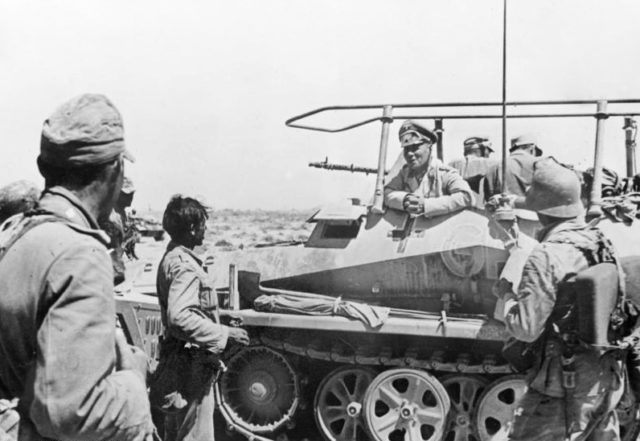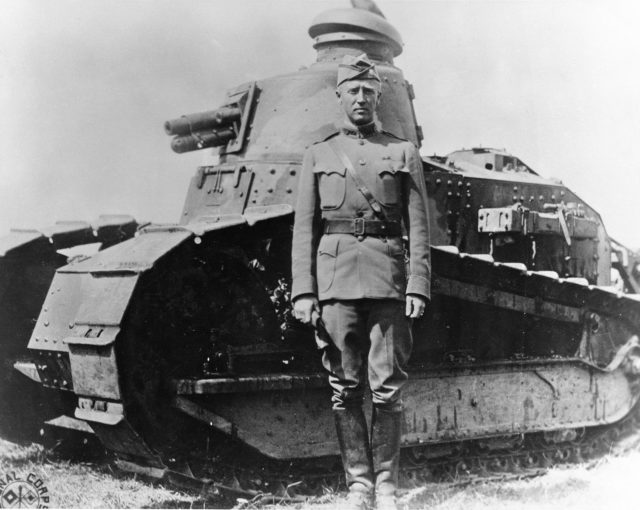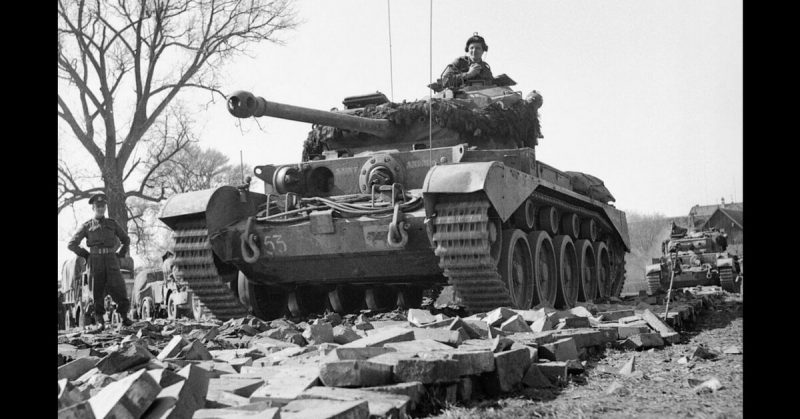The Second World War saw tanks dominate the battlefield for the first time. Gifted commanders seized this way of fighting, becoming legends.
Heinz Guderian
As a German officer in the First World War, Guderian saw the impact of British tanks. He became fascinated with the machines, specializing in them after the war. He developed tank tactics and technology, based in part on British ideas.
Guderian held an odd place in Hitler’s regime. He was trusted by both the Fuhrer and by the old-school military and was one of the few people who could safely challenge Hitler’s opinions.
In 1938, Guderian commanded XVI Corps in taking control of the Czech Sudetenland for Germany.
In the 1939 invasion of Poland, he led XIX Corps, a combination of tanks and motorized infantry. Leading from near the front, he kept his men motivated and paid detailed attention to problems with machines.
During the 1940 invasion of France, Guderian’s swift armored advance isolated the British at Dunkirk, forcing their withdrawal. He then turned south, cutting off French forces around the Maginot Line.

Guderian led nine divisions for Operation Barbarossa, the invasion of Russia. He made such decisive advances that one of his Russian opponents was executed for his failures. As the German advance wavered, he still led from the heart of the action, winning the loyalty of his men. After the fall of Kiev, he reorganized and resupplied his troops in ten days, an enormous logistical achievement.
As Barbarossa collapsed, Guderian tried to talk Hitler into changing his plans. All his evidence and reasoning failed. After clashing with his superior von Kluge, he was relieved of duty in December 1941.
Guderian was reinstated in February 1943, becoming Inspector-General of Armored Troops where he helped to increase the production of tanks but he was never again given tank command. At the end of the war, returning from sick leave, he joined a Panzer company and was captured alongside the tanks he loved.
Erwin Rommel
Rommel first gained attention in the First World War. As a young German officer, he experienced mobile warfare on the Romanian and Italian fronts, avoiding the bogged down trench fighting. Smart and courageous, he earned several of Germany’s highest honors, including two Iron Crosses.

Politically astute, Rommel ingratiated himself with the Nazi leadership as they took control of Germany. His style of command involved more micro-management than was usual in Germany, but because of his political connections, it did not hinder his career.
At the start of the Second World War, Rommel commanded the troops guarding Hitler’s headquarters during the invasion of Poland. He then used Hitler’s favor to win command of a Panzer Division, skipping the usual line for a promotion.
In France, Rommel proved his worth as a tank commander. Using the boldness that had won him distinction in the previous war, he led his division in a decisive advance. He waded into icy waters and wielded a machine gun during a difficult river crossing. His troops were credited with capturing 100,000 Allied prisoners.
When Italian troops were in trouble in North Africa, Rommel was sent to help them. It was to be a token effort, but a bold strike by Rommel drove the British back. Two years of back-and-forth campaigning followed. Operation Torch, in which the Americans arrived, opened a second front and led to the defeat of Axis forces in North Africa.
Briefly involved in the defense of Italy, Rommel was then moved to Normandy. He prepared defenses and fought against the 1944 Allied invasion. However, his tactical flexibility was limited by Hitler’s commands.
In July 1944, he was severely wounded when a British fighter strafed his car. While recuperating, he was implicated in a plot to kill Hitler. Given a choice between suicide and a show trial, he took his own life on October 14.

George Patton
In some ways, Patton was as old-fashioned a figure as the United States could produce. The son of a wealthy southern family, he trained as a cavalry soldier and served in the USA’s last real cavalry campaign in Mexico.
Taken to Europe as part of Pershing’s command staff in 1917, he had the opportunity to serve with tanks. He embraced this substitute for his beloved cavalry.
Between the wars, Patton became an advocate for armored warfare. In 1940 he was given command of the 2nd Armored Division.
American ground troops entered the North African war with Operation Torch in 1942. Patton was the senior armored commander. He was given overall command of II Corps after the American failure at Kasserine Pass in March 1943. He rebuilt the corps’ broken morale and efficiency.
After the Allies had driven the Axis out of North Africa, Patton commanded the Seventh Army for the invasion of Italy. By now, his rivalry with the British General Montgomery was poisoning Allied efforts in the Mediterranean. Despite this, the Italian landings were a success. Patton, now a lieutenant general, made such fast progress it shocked both sides.
Then came the moment that made him infamous. In a field hospital, he slapped a shell-shocked soldier, accusing him of cowardice. When word reached the press, he was relieved of his command.
Even on the bench, Patton played a role in the war. His ostensible leadership of an imaginary army helped trick the Germans about the location of the D-Day landings.
Once Allied forces were in Normandy, Patton was put in charge of the Third US Army. He made such swift advances it left the enemy reeling and his tanks out of fuel.
As the Allies crossed Europe, Patton maneuvered to secure the fall of Metz and launched a strong counter-attack during the Battle of the Bulge. Decisive maneuvers over large areas suited the man nicknamed “Old Blood and Guts.”
As the war ended, Patton was unhappy at US withdrawals in favor of the Soviet army. His impolitic comments to the press saw him once again removed from his post.
It would be the last time. While still in Germany, he was involved in a car crash and died from his injuries.
Sources:
Nigel Cawthorne (2004), Turning the Tide: Decisive Battles of the Second World War.
Jill Edwards, ed. (2012), El Alamein and the Struggle for North Africa.
David Fraser (1993), Knight’s Cross: A Life of Field Marshal Erwin Rommel.
B. H. Liddell Hart, ed. (1953), The Rommel Papers.
Richard Holmes, ed. (2001), The Oxford Companion to Military History.
David Rooney (1999), Military Mavericks: Extraordinary Men of Battle.
